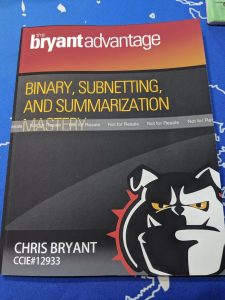CCNA 200-301 Practice Exam: Static Route Types
We use the umbrella term “static routing” quite often, but there are several different types of static routes. For success on your CCNA 200-301 exam, you need to know what each one looks like and when to use them. That’s exactly why I created this practice exam for you. Questions at the top, answers at the bottom. – and if you have any questions about these questions, tweet me @ccie12933. Let’s have at it!
Question 1:
All traffic that leaves R5 must pass through R6. What specific type of static route would be perfect for R5 in that it would allow all packets to be properly routed to R6 while keeping R5’s table as small as possible?

A. host
B. default
C. loopback
D. floating
Question 2:
What type of static route is shown here?
S* 0.0.0.0/0 [1/0] via 172.12.123.2
A. default
B. loopback
C. floating
D. host
Question 3:
A default static route will have all zeroes for which of the following values? Choose two.
A. destination IP network
B. source IP network
C. destination MAC address
D. source MAC address
E. subnet mask
F. wildcard mask
Question 4:
You’re using the ip route command to create a static route. At the point in the command shown here, what two options do you have?
R3(config)#ip route 2.2.2.0 255.255.255.0
A. The next-hop router’s IP address.
B. next-hop MAC address
C. local router exit interface’s IP address
D. local router exit interface’s name
Master subnetting for your CCNA, CCNP, and Network+ exams with my Binary Math Mastery book on Amazon…
… and you’ll get all the subnetting practice you need with my CCNA Subnetting Success Practice Exam Pack on Udemy!
And now… the answers!
Question 1: “B”. A default static route on R5 would be perfect here. For example, R5 might have 100 routes in its IP routing table and the next-hop IP address for every single route is going to be 10.1.1.6. We can shrink that table down to a single route that points to 10.1.1.6, and that has two major benefits — it shrinks the table on R5 and makes routing a little bit faster while still routing packets correctly. Win-win!
Question 2: “A”. The asterisk indicates a default route, and since it’s a static route to begin with, that makes it a default static route.
Questinon 3: “A” and “E”. All static route types on a Cisco router are written with the ip route command; it’s what you do after that that makes the difference. A default static route will have all zeros for both the destination network and the subnet mask. It’ll look like this: ip route 0.0.0.0 0.0.0.0 (next-hop address or local exit interface name).
Question 4: “A” and “D”. As mentioned in the previous answer, you can end the ip route command with either the IP address of the remote device to whom we’re forwarding the packets or the local router’s exit interface name.
That’s it for today! More CCNA 200-301 practice exams await you here on the site, and there’s a new one on that page at least six times a week. Visit early and often — and for more practice exams, check out my CCNA Subnetting Practice Pack on Udemy!






